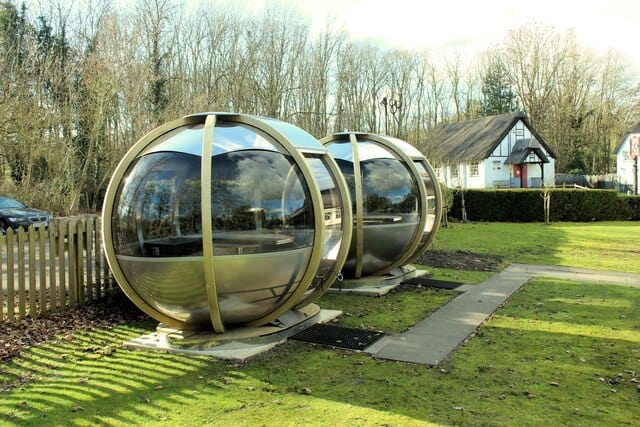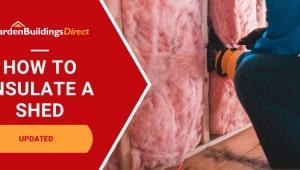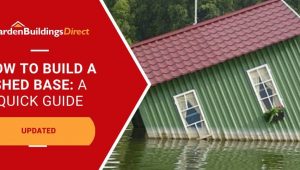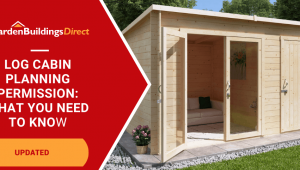Jump to:
Manufacturers are getting more creative with styles, combination designs, and shapes when coming up with garden rooms. Modern models, particularly garden pods, are good evidence of this. Even so, many people are still puzzled by these pod-like structures. If that sounds like you, here’s what you need to know.
Garden Pods Explained

Technically, garden pods are just another term for garden rooms. Many owners consider their outdoor room to be their own garden pod. However, the term is also associated with a specific dome construction, giving them a distinctive edge. For context, these are freestanding structures with a spherical or pill-shaped design. They’re usually made from wood or glass, or sometimes both (e.g., where timbers act as arcs), giving them a luxurious take on an igloo.
A reflective stainless steel cover is commonly attached and flows over to the arched roof to reduce heat. This ensures the temperature inside remains comfortable even on the warmest of days.
Inside, there can be built-in seating that can accommodate up to 7 guests (more or less), which can also be lowered and transformed into a lounge bed. The footprint is no larger than a regular patio set, though this can vary depending on the model and manufacturer.
Other options come as blank canvases for personalised use. Their purpose is much the same as other outdoor buildings, like log cabins or summer houses. You can utilise them as an entertainment space, hobby room, or garden office, to name a few, based on the pod’s dimensions.
Note: The features can differ between models and manufacturers.
Garden Pods ‘Rotate 360º’ Feature
If there’s one thing that makes garden pods stand out, it’s their rotating seater, which allows you to enjoy 360-degree panoramic views. This grants you the versatility to position it in the sun, shade, or sheltered from the wind. With this design alone, they make for a brilliant focal point in any garden. It’s likely to add more property value, especially for those after a stylish addition to their home.
Just to clarify, though, this ‘rotate 360º’ feature is meant for positioning as desired, not constant rotation—that is, it will not keep rotating. Also, not all garden pods have this feature. If you’re keen on having it, be sure to check the design details of the model you’re considering.
Insulation for Year-Round Comfort and Use
Glass windows, especially single-glazed ones, or alternative materials like acrylic are poor insulators on their own. And with fewer timber parts, heat can easily escape in the colder months or sneak in during the warmer ones. However, with insulation, the pod can maintain a more stable internal temperature and even provide soundproofing.
Like most quality garden rooms, these pods are available in pre-insulated units. This upgraded feature comes as standard upon purchase but with additional cost. It’s a worthwhile investment, though, as it saves you the hassle of installing it yourself or the extra expense of hiring a professional.
Garden Pod Foundations
Garden pods, with their dome structure, need a hardstanding, level base. A common design for the base is to have it circular, too. Here’s how it’s usually set up: the base layer is a solid deck, and the second, much smaller layer houses the rotating mechanism. The pod itself sits on top of this rotating layer.
The foundation can be made from decking or cement, and the size depends on the pod’s dimension. Given its weight and the fact that it can be rotated, a foundation prevents it from shifting and ensures it stays in place and rotates as designed.
For more details, have a look at this guide on ‘Does a Garden Room Need a Base?’
Garden Pods Planning Permission
Garden pods are typically small outdoor structures that don’t take up much space, so in most cases, they don’t need planning permission. However, if the pod exceeds 15m², you’ll need to ensure it’s built at least 1m from your neighbour’s boundary to comply with building regulations.
Also, if you’re in a National Park or an Area of Outstanding Natural Beauty (AONB), you’ll likely need planning permission. And if your property is a Listed Building, then planning permission is definitely required.
Note: It’s always better to double-check the planning requirements before you start building. It saves you time, money, and stress down the line.
If you decide to invest in one, here are some ‘Ideas for Small Garden Rooms’ to get your creativity flowing.





